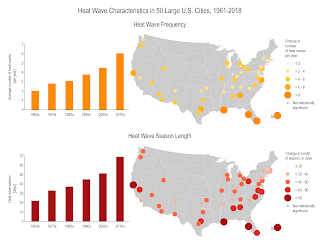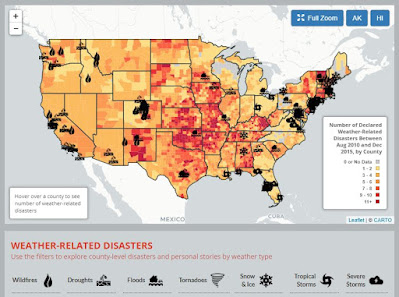We are discussing extreme weather events this week. This video from National Geographic is a great one as an introduction to the material showing the interconnectivity of events.
I'll be focusing on Heat waves. They occur more often than they used to in major cities across the United States, from an average of two heat waves per year during the 1960s to more than six per year during the 2010s. ... The average heat wave season across 50 major cities is 47 days longer than it was in the 1960s.
Last summer California had the hottest August and September on record. The high temperature 97° in #SantaCruz on October 16th exceeded the previous record 96° on that day in 1974 and 1967!
- Provide community cooling centers, particularly in areas with low-income, elderly, and young populations
- Ensure proper functioning of energy and water systems
- Encourage citizens to check on their family, friends, and neighbors to ensure they have access to air conditioning
- Communicate heat warning information and appropriate responses to the public (e.g., encourage staying indoors, provide symptom reminders)
- Establish systems such as hotlines to alert public health officials about high-risk or distressed individuals
- Encourage energy conservation to reduce demand on electricity systems
- Implement load restrictions for older roads, bridges, and rail to reduce traffic on vulnerable transportation infrastructure
On sites like the Environmental America’s Extreme Weather Map (below) one can see an interactive visual map with information of weather-related disasters 2010-2015. Every year, weather-related disasters injure or kill hundreds of Americans and cause billions of dollars in damage. Many of the risks posed by extreme weather will likely increase in a warming world. Scientists have already noted increases in extreme precipitation and heat waves as global warming raises temperatures and exacerbates weather extremes.
The WunderMap is a really useful site to see the severe weather occurrences updated in the States.
Any of the websites I used here are great places to keep yourselves informed so we can prepare for an extreme weather event.
Stay safe and informed!


Hey Ms. Garcia,
ReplyDeleteI really enjoyed your blog post this week. I assume it's fine if I use yours as my comment for the week as it seems no one else has posted at this moment. I found your information on heat waves to be heavily informative as I had noticed an increase in temperature over the years but I was sure what the underlying cause was. Also, your list of preventative measures was very detailed and provided a variety of different solutions for the U.S. moving forward.
regards,
Bryan Gallardo
905097202
Loved having your comment here! (you can use my blog anytime)
ReplyDelete